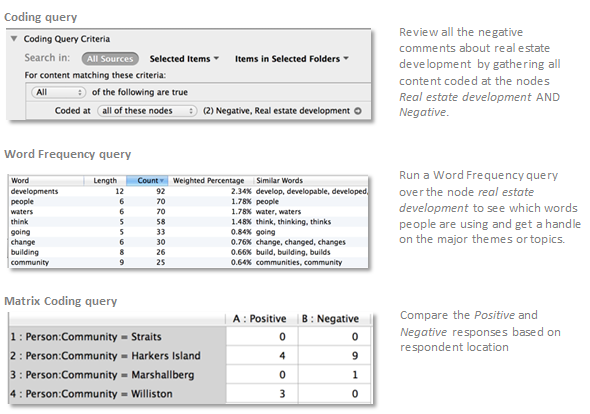Move forward with queries and visualizations
This topic describes some of the ways queries and visualizations can support you at each stage of the research process.
In this topic
- Get started with queries and visualizations
- Query and visualize during your literature review
- Query and visualize during data analysis (coding)
Get started with queries and visualizations
Queries and visualizations support the iterative nature of qualitative research and help you to investigate hunches as you progress through your project.
It is a good idea to start running queries early on—they can help you focus on the questions you want to ask (and prompt you to code accordingly). They can also help you to determine whether you need to gather additional sources of data or re-frame the questions you are asking.
To start with, you may want to run some simple queries and preview the results—refer to About queries to get up and running. As you grow in confidence, you can look at building more complex criteria and storing your results in nodes.
When you begin using queries it can help to remember:
-
Coding queries rely on the work you have done— patchy or inconsistent coding may yield less useful results.
-
Review the query results and make a memo to describe how it contributes to your understanding.
-
While queries and visualizations can give you different perspectives on your data, you will still need to use your analytical skills to interpret the results.
-
Saved queries can act as 'signposts' for future investigation, set them up early and rerun them as you progress through your project.
Query and visualize during your literature review
You can use NVivo for your literature review—and as your project progresses, you may return to the literature to see where your findings support or contradict those of other authors. As you conduct your literature review, you might use the following queries to explore the material:

Query and visualize during data analysis (coding)
Early on in your project, Text Search and Word Frequency queries can help you to organize your data into broad categories. For example, you could use a Text Search query to search for real estate development and automatically code all of the occurrences.
As you move into more detailed coding and continue to organize or 'segment' your data by theme—queries can help you to reassemble and examine the themes in ways that address your research question. For example, you may want to explore the co-occurrence of themes (show me content coded at development AND water quality).
Rather than being a one-step process, querying your coding is iterative—one query or visualization may lead to another as you dig deeper into your data.
For example, to explore the idea that respondents are pessimistic about real estate development, you might run the following queries:



